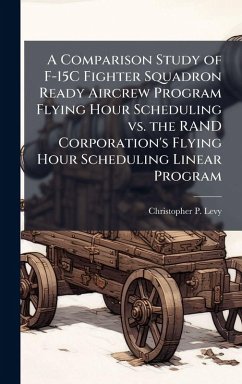
Aircrew Performance Cutting-Edge Tech
Versandkostenfrei!
Versandfertig in über 4 Wochen
27,99 €
inkl. MwSt.
Weitere Ausgaben:

PAYBACK Punkte
14 °P sammeln!
Introduction to human performance -- Fatigue operations -- Vision enhancement/refractive eye surgery -- Nuclear biological and chemical (NBC) threat environment and the Tactical air (TACAIR) operator -- Directed energy weapons/battlefield lasers -- Mishap reduction -- Conclusions/recommendations. Appendix A: US Navy corneal surgery policy. "Using cutting-edge technology to create a human factors advantage in military operations will contribute to success on the battlefield of the future whether below the surface, on the surface, in the air, or in space. Human factors system selection in the pa...
Introduction to human performance -- Fatigue operations -- Vision enhancement/refractive eye surgery -- Nuclear biological and chemical (NBC) threat environment and the Tactical air (TACAIR) operator -- Directed energy weapons/battlefield lasers -- Mishap reduction -- Conclusions/recommendations. Appendix A: US Navy corneal surgery policy. "Using cutting-edge technology to create a human factors advantage in military operations will contribute to success on the battlefield of the future whether below the surface, on the surface, in the air, or in space. Human factors system selection in the past has appeared to be arbitrary and intermittent, with no unifying vision and apparently little or no coordination between the military services. Mature, timely applied technology will reduce risk and enhance combat capability. By decreasing mishaps during training and combat, there will be a reduced number of lost lives of highly trained and costly aircrew, while preserving training and combat assets (aircraft/unmanned vehicles). A concomitant increase in survivability through better understanding of human factors technology will ultimately give the modern aviation warrior a tactical edge throughout the full spectrum of combat and provide secondary benefits to the civilian aviation sector. This paper will explain currently available and emerging aviation human factors technological advances in today's military aviation weapons systems and recommend a vision (and direction) for the most promising, emerging aviation human factors-related technological advances. Emerging human factors areas addressed in this paper include fatigue; vision enhancement/refractive eye surgery; nuclear, biological, and chemical weapons; directed energy weapons; mishap reduction; service culture; situational awareness; spatial disorientation; simulation; and training. This work has been selected by scholars as being culturally important, and is part of the knowledge base of civilization as we know it. This work was reproduced from the original artifact, and remains as true to the original work as possible. Therefore, you will see the original copyright references, library stamps (as most of these works have been housed in our most important libraries around the world), and other notations in the work. This work is in the public domain in the United States of America, and possibly other nations. Within the United States, you may freely copy and distribute this work, as no entity (individual or corporate) has a copyright on the body of the work. As a reproduction of a historical artifact, this work may contain missing or blurred pages, poor pictures, errant marks, etc. Scholars believe, and we concur, that this work is important enough to be preserved, reproduced, and made generally available to the public. We appreciate your support of the preservation process, and thank you for being an important part of keeping this knowledge alive and relevant.












